Caryn

 My sister-in-law, Jennifer Parmely is a Labor and Delivery nurse, and has been for about 40 years. I have no idea how many babies she has assisted in delivering, nor how many she has delivered herself, but I can imagine. Taking a wild guess, I would say between 20,000 and 50,000. That’s about the population of a small city. Now I could be off, but I don’t think so. I can’t say how many she has actually delivered, because they came before the doctor could get there, but I imagine there were some of those too. Jennifer has never wanted to be anything but a Labor and Delivery nurse. I have never seen anyone so focused. She knew what she wanted to do in high school and she has never waivered.
My sister-in-law, Jennifer Parmely is a Labor and Delivery nurse, and has been for about 40 years. I have no idea how many babies she has assisted in delivering, nor how many she has delivered herself, but I can imagine. Taking a wild guess, I would say between 20,000 and 50,000. That’s about the population of a small city. Now I could be off, but I don’t think so. I can’t say how many she has actually delivered, because they came before the doctor could get there, but I imagine there were some of those too. Jennifer has never wanted to be anything but a Labor and Delivery nurse. I have never seen anyone so focused. She knew what she wanted to do in high school and she has never waivered.
Of course, Jennifer, like everyone else, is more than her career. She is mom and grandma, or in her case, Oma.  Jennifer had three sons, Barry Schulenberg, JD Parmely, and Eric Parmely, and now, she has four grandchildren, Reagan, Hattie, Bowen, and Maeve Parmely. She cherishes her family, which includes, daughters-in-law, Kelli Schulenberg and Ashley Parmely. Jennifer love getting together with all of her family, but she also loves taking each of her grandchildren for a day that is all their own. They often go shopping, and of course, that includes a toy of their choosing. They love going with her, and it is a treasured special time for her too.
Jennifer had three sons, Barry Schulenberg, JD Parmely, and Eric Parmely, and now, she has four grandchildren, Reagan, Hattie, Bowen, and Maeve Parmely. She cherishes her family, which includes, daughters-in-law, Kelli Schulenberg and Ashley Parmely. Jennifer love getting together with all of her family, but she also loves taking each of her grandchildren for a day that is all their own. They often go shopping, and of course, that includes a toy of their choosing. They love going with her, and it is a treasured special time for her too.
Another thing that Jennifer has never waivered in, is her health. Years ago, after having three children, Jennifer, like many mothers, had some extra weight to lose. She made the decision to get that weight off and get healthy, and she never waivered. Diet was a major part of her transformation, of course, but just as important was the strict exercise “routine” Jennifer had. I emphasize “routine” because, she never thought of it that way, exactly. Jennifer began to be an 
 energetic, fast-paced, “everything” exercise enthusiast…she hiked, did yoga, skied, every exercise machine she could at the gum, you name it, Jennifer probably tried it. Like most of us, there were forms of exercise she likes better than others, but she has never gone back to a sedentary lifestyle, and she has never stopped eating healthy…that has kept her healthy for many years now. Today is Jennifer’s 60th birthday, and well…she certainly doesn’t look 60. Years of healthy living have certainly paid off. Happy birthday Jennifer!! Have a great day!! We love you!!
energetic, fast-paced, “everything” exercise enthusiast…she hiked, did yoga, skied, every exercise machine she could at the gum, you name it, Jennifer probably tried it. Like most of us, there were forms of exercise she likes better than others, but she has never gone back to a sedentary lifestyle, and she has never stopped eating healthy…that has kept her healthy for many years now. Today is Jennifer’s 60th birthday, and well…she certainly doesn’t look 60. Years of healthy living have certainly paid off. Happy birthday Jennifer!! Have a great day!! We love you!!
 I think most of us have heard about the Louisiana Purchase, but I don’t know if I really ever knew the whole story. Maybe it was taught in school, but somehow I missed it. It really was one of the great surprises in diplomatic history.
I think most of us have heard about the Louisiana Purchase, but I don’t know if I really ever knew the whole story. Maybe it was taught in school, but somehow I missed it. It really was one of the great surprises in diplomatic history.
French Foreign Minister Charles Maurice de Talleyrand because he was the foreign minister to French Emperor Napoleon Bonaparte, was one of the most powerful men in the world. Talleyrand had convinced Napoleon that he could create a new French Empire in North America. The French had long had a rather weak claim to the vast area west of the Mississippi River known as Louisiana Territory. The Louisiana Territory was going to be his starting place for that power in North America. In 1800, Napoleon secretly signed a treaty with Spain that officially gave France full control of the territory. Then, Napoleon began preparing the French army to occupy New Orleans and bolster French dominion. President Thomas Jefferson heard about Napoleon’s plans in 1802. It was an alarming revelation, especially in light of Napoleon’s desire for world domination. having him in control of part of North America brought him a little close for comfort. Also, Jefferson knew that the United States would need to expand 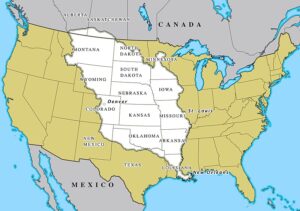 westward beyond the Mississippi, but she could never challenge the French militarily for the territory. Jefferson’s minister in France, Robert Livingston, had a lot riding on his ability to negotiate an agreement whereby Napoleon would give the United States control of New Orleans, the gateway to the Mississippi River.
westward beyond the Mississippi, but she could never challenge the French militarily for the territory. Jefferson’s minister in France, Robert Livingston, had a lot riding on his ability to negotiate an agreement whereby Napoleon would give the United States control of New Orleans, the gateway to the Mississippi River.
Livingston’s initial attempts at reaching a diplomatic agreement failed, and the situation looked bleak, but then in early 1803, Jefferson sent his young Virginia friend James Monroe to Paris to assist Livingston. By that time Napoleon’s situation in Europe had changed for the worse. He had stirred things up enough that war between France and Great Britain seemed imminent. Napoleon could no longer spare the military resources needed to secure control of Louisiana Territory. Rather than lose the territory to a British takeover, Napoleon reasoned it would be better to sell Louisiana to the Americans.
So, in the end, it wasn’t the expert negotiating skills of Livingston and Monroe, but rather Napoleon’s need to unload the territory. On this day April 11, 1803, much to Livingston’s surprise, the French minister coolly asked, “What will you give for the whole?” He was offering no the whole of New Orleans, but the whole of Louisiana Territory. Livingston and Monroe knew that for whatever reason, they were being offered “the moon” and they  should jump on the opportunity. Livingston and Monroe discussed France’s proposed cost for the territory. Several weeks later, on April 30, 1803, the American emissaries signed a treaty with France for a purchase of the vast territory for $11,250,000.
should jump on the opportunity. Livingston and Monroe discussed France’s proposed cost for the territory. Several weeks later, on April 30, 1803, the American emissaries signed a treaty with France for a purchase of the vast territory for $11,250,000.
The move was a good one for Napoleon too, because a little more than two weeks later, Great Britain declared war on France. Napoleon had to abandoned his dreams of a North American empire with the sale of the Louisiana Territory, but he also achieved a goal that he thought more important. “The sale [of Louisiana] assures forever the power of the United States,” Napoleon later wrote, “and I have given England a rival who, sooner or later, will humble her pride.”
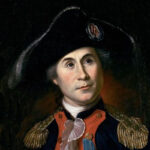 Pirates, as we know them, are criminals who hijack ships to rob them of anything of value on board. Sometimes however, a “pirate” can actually be working for the government, or at least on behalf of the government. Such was the case on April 10, 1778, when Commander John Paul Jones and his crew of 140 men aboard the USS Ranger set sail from the naval port at Brest, France. They headed toward the Irish Sea. Their mission was to begin raids on British warships. This was the first mission of its kind during the Revolutionary War. These missions weren’t called piracy, but when we compare the two acts, they pretty much were piracy. They just weren’t for personal gain, but rather for the good of the country and the war effort. No one was safe, not passengers and certainly not the crew.
Pirates, as we know them, are criminals who hijack ships to rob them of anything of value on board. Sometimes however, a “pirate” can actually be working for the government, or at least on behalf of the government. Such was the case on April 10, 1778, when Commander John Paul Jones and his crew of 140 men aboard the USS Ranger set sail from the naval port at Brest, France. They headed toward the Irish Sea. Their mission was to begin raids on British warships. This was the first mission of its kind during the Revolutionary War. These missions weren’t called piracy, but when we compare the two acts, they pretty much were piracy. They just weren’t for personal gain, but rather for the good of the country and the war effort. No one was safe, not passengers and certainly not the crew.
Commander John Paul Jones, will always be remembered as one of the most daring and successful naval commanders of the American Revolution. John Paul Jones was born under the simple birth name of John Paul on July 6, 1747, in a small cottage in Arbigland, Scotland, to John Paul Sr and Margaret Paul. His dad was a gardener, but Jones found his calling not in gardening, but at sea. He earned an apprenticeship with the British Merchant Marine at the age of 13. His seafaring adventures would eventually take him to America and, like many other sailors before him, Jones got involved in the slave trade. However, the realities of human trafficking repulsed him, and he returned to shipping cargo duties.
1773 found Jones in a very difficult situation. He murdered a mutinous sailor on the island of Tobago in self-defense…which is not really murder, but maybe in those days things were different. Whatever the case may be,  Jones believed he wouldn’t receive a fair trial, so he fled to America. It was there he added the last name “Jones” to conceal his identity. Jones needn’t have worried, because the American colonies were too busy stoking the flames of war with the British to have noticed his past. When the American Revolution broke out in 1775, Jones who remembered Britain’s cruel treatment of the Scots, decided that he would side with the colonists. He joined the new Continental Navy.
Jones believed he wouldn’t receive a fair trial, so he fled to America. It was there he added the last name “Jones” to conceal his identity. Jones needn’t have worried, because the American colonies were too busy stoking the flames of war with the British to have noticed his past. When the American Revolution broke out in 1775, Jones who remembered Britain’s cruel treatment of the Scots, decided that he would side with the colonists. He joined the new Continental Navy.
Jones began skillfully attacking British ships off the American coastline and expanded his operations from there. He first captained the USS Providence, set sail to Nova Scotia, and started capturing British vessels. Next, he took command of Ranger and set course to France, where his vessel was saluted by the French Admiral La Motte Piquet. It was the first American vessel ever to be recognized by a foreign power…pretty good for a new country. In 1779 Jones made history as one of the greatest naval commanders of the Revolutionary War. His shining moment came when, while En route to raid British shipping, Jones’ warship, Bon Homme Richard, came head to head with the more powerful English warship HMS Serapis off the North Sea. The battle went on for three hours between the two vessels. At one point, Jones slammed Bon Homme into Serapis, strategically tying them together. As the story goes, when the British asked if Jones was ready to surrender, he famously responded, “I have not yet begun to fight!” Inspired by Jones’ bravado, one of his naval officers tossed a grenade onto Serapis. The severe damage caused the British to surrender in the end. Jones’ became an 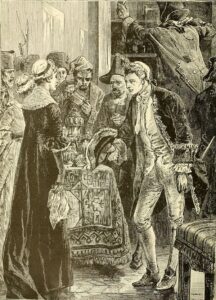 international hero. After the war ended, the Continental Navy dissolved due to lack of funds. Jones was dubbed the father of the United States Navy.
international hero. After the war ended, the Continental Navy dissolved due to lack of funds. Jones was dubbed the father of the United States Navy.
Jones retired to Paris, but his health took a turn for the worse. On July 18, 1792, he was found dead in his apartment at the age of 45. He was laid to rest in a French cemetery, but the plot of land was later sold and forgotten. Over one hundred years would pass before the United States was able to recover Jones’ remains with the help of French officials. After much research, his body was located and exhumed, and to the surprise of French pathologists, Jones’ body was excellently preserved. His initial autopsy concluded that the cause of his death was kidney failure, with later clinical studies believing his condition was exacerbated by a heart arrhythmia. The United States received Jones’ remains and buried them in a tomb inside the chapel of the U.S. Naval Academy in Annapolis, Maryland.
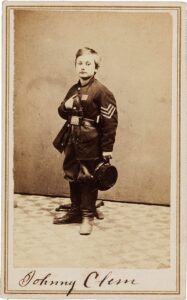
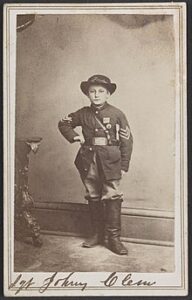 During the Civil War, military personnel was often short supply, and so, soldiers weren’t always adults. Sometimes, children enlisted, and sometimes they were “hired” on as messengers, scouts, and servants. They also might be hired on as musicians, such has drummers or buglers. On ships, children carried powder to fire the cannons, earning the nickname “powder monkeys.” In fact, one in five soldiers during the Civil War was under the age of 18.
During the Civil War, military personnel was often short supply, and so, soldiers weren’t always adults. Sometimes, children enlisted, and sometimes they were “hired” on as messengers, scouts, and servants. They also might be hired on as musicians, such has drummers or buglers. On ships, children carried powder to fire the cannons, earning the nickname “powder monkeys.” In fact, one in five soldiers during the Civil War was under the age of 18.
One such musician was Drummer John Joseph Klem. A popular legend suggests that Klem served as a drummer boy with the 22nd Michigan at the Battle of Shiloh. Legend has it that Klem came very near to losing his life when a fragment from a shrapnel shell crashed through his drum, knocking him unconscious and that subsequently his comrades, who found and rescued him from the battlefield, nicknamed Klem “Johnny Shiloh.” Klem slayed enemies in the Battle of Chickamauga…shooting a Confederate officer. Though Klem was only 10 years old, the Union made him a sergeant. Now imagine taking orders from a 10 year old sergeant.
Klem was born on August 13, 1851, to Roman and Magdalene Klem. His mother was killed crossing the railroad tracks when he was just 9 years old. As devastating as that was, his father’s second marriage was worse. John did not get along with his stepmother, and I suppose that could have contributed to his wanderlust spirit. He attended school in Newark, but often skipped school so he could drill as a drummer boy with a local unit…Company H, 3rd Ohio Volunteer Infantry. Like many people of that time, Klem felt strongly about the Civil War, but it was probably unusual for such a young boy to feel that way. Most likely the main factor the problems with his stepmother, making life at home unpleasant. His relatives joining up was probably another factor.
Motivating Klem was the fact that many of his relatives had enlisted in the army. He also deeply admired the president. In fact, he so admired President Lincoln that he changed his middle name to Lincoln. Because of his young age, recruiters turned Klem down when he tried to enlist. Several regiments passed through Newark on the way to the War. Klem immediately went to each and tried to join up, but each time he was turned down because of his age. He tried a new tactic, and traveled by train to try to enlist. That failed too, because he was always recognized by a friend or relative and sent home. Finally, Klem just ran away from home, to join the Army in 1861, at the age of 9. He finally got far enough away from home that they let him stay. Even then, he didn’t really enlist, because he was still too young. They allowed him to join the Michigan unit because they knew he would not give up until somebody let him join. When he offered his services as drummer to a company commander of the Third Ohio Volunteer Regiment, the captain looked him over and said he wasn’t “enlisting infants.” Johnny then tried to join the Twenty-second Michigan Regiment and was refused. Finally, he simply “went along with the regiment just the same, as a drummer boy, and though not on the muster roll, drew a soldier’s pay of thirteen dollars a month.” His pay was contributed by officers of the regiment.
At some point, Johnny Klem became Johnny Clem, although I am not sure just when. When Johnny Clem enlisted in the Army, legally or not, his intention was to stay. He might have been just a drummer boy at first, but when the shell hit his drum, he was not scared. Over the years of his service, he proved himself to be an invaluable member of the unit. He gained fame for his bravery on the battlefield, and became the youngest soldier ever to achieve the rank of sergeant, and I expect that record still stands. Clem retired from the United States Army in 1915, having attained the rank of brigadier general in the Quartermaster Corps. At the time of his retirement, he was the last veteran of the American Civil War still on duty in the US Armed Forces. By 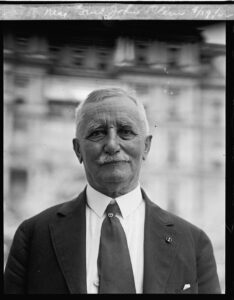
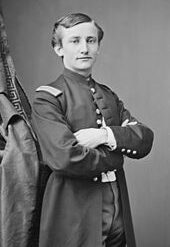 special act of Congress on August 29, 1916, he was promoted to major general one year after his retirement.
special act of Congress on August 29, 1916, he was promoted to major general one year after his retirement.
Clem was married twice. He first married Anita Rosetta French in 1875, and after her passing in 1899, he met and married Bessie Sullivan of San Antonio in 1903. Sullivan was the daughter of a Confederate veteran. Clem enjoyed that fact, and often said, that he was “the most united American” alive. Clem was the father of three children. After his retirement in 1915, Clem lived in Washington DC before returning to San Antonio, Texas. Just as he had as a child on the battlefield, Clem defied the odd, living a long and healthy life. He died in San Antonio at the age of 85 on May 13, 1937, and was buried in Arlington National Cemetery in Arlington County, Virginia.
 It seems to me that whenever we, as a nation or a people, get a little lackadaisical concerning the safety of our citizens, we find ourselves falling victim to the very thing we thought was no longer a threat. I think most people know that pirates used to be a big problem, but I wonder if people realize that they still are a big problem. We all thought that airplane hijackers were a thing of the past…until 9-11, and then we knew that evil still existed, no matter how tightly we closed our eyes to it.
It seems to me that whenever we, as a nation or a people, get a little lackadaisical concerning the safety of our citizens, we find ourselves falling victim to the very thing we thought was no longer a threat. I think most people know that pirates used to be a big problem, but I wonder if people realize that they still are a big problem. We all thought that airplane hijackers were a thing of the past…until 9-11, and then we knew that evil still existed, no matter how tightly we closed our eyes to it.
As far as the United States was concerned, pirates had not captured a ship sailing under the American flag since the 1820s, so why would it happen now? They assumed that our ships were safe…maybe because they flew the American flag or maybe because pirates were really a thing of the past. On April 8, 2009, they found out just how wrong they had been, when the MV Maersk Alabama was hijacked off the coast of Somalia. This hijacking was a very big deal, and drew worldwide attention to the problem of piracy in the waters off the Horn of Africa. Decades of instability in Somalia, as well as a lack of policing in its territorial waters led to a resurgence of piracy in the region that peaked in the late 2000s. Evil simply can not be expected to fade away. In fact, just a day before the attack, the Maersk Alabama received warning from the United States government to stay at least 600 miles off the coast of Somalia. Unfortunately, Captain Richard Phillips decided that keeping the ship about 240 miles from the coast would be sufficient. It was to be a decision that was later criticized by members of his crew, who saw it as reckless.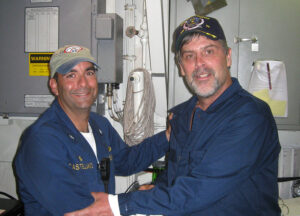
On April 8, members of the crew saw a skiff carrying four armed pirates approaching their ship, Immediately, they initiated the protocol for a hijacking. Chief Engineer Mike Perry got most of the crew to a safe room and managed to swamp the pirates’ craft by swinging his ship’s rudder. Nevertheless, the pirates were able to get onboard and take Phillips hostage. After one of the pirates was injured fighting with the ship’s crew, the remaining three pirates kidnapped Phillips and fled in a lifeboat, planning to use him as a bargaining chip.
The USS Bainbridge arrived early the next morning along with another United States Navy vessel. A three-day standoff followed. The pirates continued to hold Phillips hostage in the lifeboat. Negotiation attempts failed, and at one point the pirates fired at the destroyer, doing no damage. Finally, on April 12, Navy SEAL snipers opened fire on the lifeboat. It must have seemed to Phillips that they had sacrificed his life, to save the ship, but in a stunning display of accuracy, the SEALS firing from a ship’s deck through the windows of the tiny boat, hitting all three pirates in the head, killing them instantly. Phillips was unharmed, and hopefully came away a much  wiser man and a much better captain to his crew.
wiser man and a much better captain to his crew.
The surviving pirate, Abduwali Muse, was taken into custody and later sentenced to over 33 years in United States prison, having been tried as an adult, even though he and the other hijackers were reportedly all teenagers when they hijacked the MV Maersk Alabama. Piracy is still an issue in the region…even targeting the MV Maersk Alabama herself four times 2009 and 2011, each of which was repelled by armed security teams. The attacks were attempted, but being ready and willing to fight staved off the attacks.

 I can’t think of anything that is harder for a mom than watching your child go through some of the worst events of their lives. Many people who go through that kind of thing, would sit down and stew in their depression, but not my niece, Chantel Balcerzak. The past year has been harder on her and her daughter, Siara Olsen than it was for a lot of us. On January 25, 2020, Siara’s three month old son, Alec passed away after a short illness. On top of that her marriage fell apart, and she got divorced. It was the worst time of her life, and she needed the love and support of her family. Chantel stepped in and Siara moved home for a time of comforting and support from her parents. Both of these girls are strong women, and they were not going to sink further into depression. Instead, they supported each other, encouraged each other, and made a plan to have a year of self improvement. Chantel’s husband and Siara’s dad, Dave Balcerzak was right there too. Giving the girls the extra support they all needed. They were all hurting, but they had to move forward.
I can’t think of anything that is harder for a mom than watching your child go through some of the worst events of their lives. Many people who go through that kind of thing, would sit down and stew in their depression, but not my niece, Chantel Balcerzak. The past year has been harder on her and her daughter, Siara Olsen than it was for a lot of us. On January 25, 2020, Siara’s three month old son, Alec passed away after a short illness. On top of that her marriage fell apart, and she got divorced. It was the worst time of her life, and she needed the love and support of her family. Chantel stepped in and Siara moved home for a time of comforting and support from her parents. Both of these girls are strong women, and they were not going to sink further into depression. Instead, they supported each other, encouraged each other, and made a plan to have a year of self improvement. Chantel’s husband and Siara’s dad, Dave Balcerzak was right there too. Giving the girls the extra support they all needed. They were all hurting, but they had to move forward.
The girls took a look at themselves, and saw that as many people had done, during the Covid-19 shutdown, they and added a few pounds and lost some muscle, and they decided it was time to get back on the right track. So they began working out over Siara’s lunches, and even set a goal for them selves. They had seen a commercial in which some chipmunks who were out of shape decided to go for “All Buff ~ No Fluff” and they made that their goal. Siara has spent a number of years in high school and college as a cheerleader, and of course, she is 23 years younger than her mom, but she tells me that sometimes Chantel beats her when they are doing pushups, so that is really cool too. Chantel doesn’t do girly pushups anymore either. They do the hard kind where you are on your hands and toes. I believe the girls will reach their final goal of looking amazing. They have already come a long way.
Siara tells me that her mom was always there for here throughout this hard, hard year. She was there to comfort her and take her mind off of her troubles, and give her advise when she needed it. When Siara moved out again and got a place of her own, Chantel was there to help her decorate it and make it her own. Chantel is 
 an artist, so of course, Siara’s place is incredibly beautiful, and that is a gift in itself. When the chips are down, Chantel is really the person you want to have in your corner. I’m very proud of her and Siara too. Today is Chantel’s 50th birthday. It’s a milestone, and she looks incredible for it. Happy birthday Chantel!! Have a great day!! We love you!!
an artist, so of course, Siara’s place is incredibly beautiful, and that is a gift in itself. When the chips are down, Chantel is really the person you want to have in your corner. I’m very proud of her and Siara too. Today is Chantel’s 50th birthday. It’s a milestone, and she looks incredible for it. Happy birthday Chantel!! Have a great day!! We love you!!

 Over the years, we have had many fashion changes. Clothing went from long skirts to mini-skirts, and back again. Jeans went from straight legs, to bell bottoms, to skinny jeans, and everything in between. Furniture went through some of the same changes. Victorian, modern, contemporary, rustic, and every other type of furniture have been the furniture of choice over the years too. Even cars have gone through “fashion” changes over the years…some were so drastic that we don’t even recognize the car anymore, like the Mustang.
Over the years, we have had many fashion changes. Clothing went from long skirts to mini-skirts, and back again. Jeans went from straight legs, to bell bottoms, to skinny jeans, and everything in between. Furniture went through some of the same changes. Victorian, modern, contemporary, rustic, and every other type of furniture have been the furniture of choice over the years too. Even cars have gone through “fashion” changes over the years…some were so drastic that we don’t even recognize the car anymore, like the Mustang.
When we think of fashion trends, we seldom focus on tires, but maybe we should. Tires have changed so much over the years, and I’m not really talking about quality. I’m talking about style. I suppose that since I’m married to a mechanic, these things might stand out to me more than other people, but I remember the different styles that my husband, Bob likes over the years, and when he would go out of his way to change the way his current tires looked. He had cars with the small white stripe around them, and he had “raised white letters” on his tires, which I must say were probably his, and my favorites. It was a cool look. In the early 1900s, the companies came out with Whitewall tires or white sidewall (WSW) tires. These tires had a stripe or entire sidewall of white rubber. These tires were most commonly used to around the mid 1970s. To me, these were not a good looking tire, especially if it was the entire sidewall, but they were a trend I suppose.
The use of whitewall rubber for tires was started by a small tire company in Chicago called Vogue Tyre and Rubber Company. They made the tires for their horse and chauffeur drawn carriages in 1914. Early automobile tires were made of pure natural rubber. To make the tread wear better, they mixed in various chemicals mixed into the tread compounds. Apparently, zinc oxide, a pure white substance that increased traction and also made the entire tire white, worked the best. In the end, white rubber did not have the endurance that was needed. They used carbon black only in the tread, and that with the white rubber produced tires with inner and outer sidewalls of white rubber. Eventually, entirely black tires became available, but since they were still made of rubber, a scrape against the curb would reveal the white rubber inside. That was actually how they finally arrived at the raised white letters that Bob and I liked so much.


Tires, like any other “fashion trend,” have changed over the years. If it wasn’t the sidewall, it was the tread design. As the manufacturers figured out better ways to make the tire grip the road better, they made the roads a safer place to drive. While their ideas weren’t always about the way a tire looked, that was a big part of the tire’s design, because if it didn’t look good, people wouldn’t buy it, even if it was a good tread design.
 Tornadoes are a common storm in some parts of the United States. The most common area for them is called Tornado Alley. Usually, when storms go through, you might hear of tornado watches. That doesn’t mean that there are multiple tornadoes in an area, but it could. In 1936, beginning on April 5th and extending through April 6th, the states of Mississippi and Georgia found themselves in the middle of a tornado outbreak, which is several tornadoes in an area, of course. This is the only continuous tornado outbreak in United States history to produce more than one tornado with triple digit death tolls. Also, severe flash floods from the associated storms caused millions of dollars in damage across the region.
Tornadoes are a common storm in some parts of the United States. The most common area for them is called Tornado Alley. Usually, when storms go through, you might hear of tornado watches. That doesn’t mean that there are multiple tornadoes in an area, but it could. In 1936, beginning on April 5th and extending through April 6th, the states of Mississippi and Georgia found themselves in the middle of a tornado outbreak, which is several tornadoes in an area, of course. This is the only continuous tornado outbreak in United States history to produce more than one tornado with triple digit death tolls. Also, severe flash floods from the associated storms caused millions of dollars in damage across the region.
The storm, called the Tupelo-Gainesville Outbreak, produced at least 12 tornadoes. The outbreak took place over two days, April 5th and 6th, but was really just about 12 hours in duration. The storm hit Tupelo, Mississippi at 8:30pm on April 5, 1936. It was the fourth-deadliest tornado in United States history. The storm came out of a group of storm cells, and first touched down in a rural area about eight miles from the city. The twister killed a family of 13, sweeping their house away as the tornado made its way toward Tupelo. Many more were injured before it even reached the city. The tornado was retroactively rated an F5 on the Fujita scale, it caused total destruction along its path through the Willis Heights neighborhood. In that area were a number of well-built large mansions that were blown away like a house of cards.
The tornado missed the business district, and instead hit residential areas, sadly…increasing the death toll. The Gum Pond area of Tupelo was the worst hit. Homes along the pond were swept into the water with their  victims. The majority of the bodies were found in Gum Pond, the area which is now Gumtree Park, but many bodies were never recovered from the pond at all. The winds were so strong, that pine needles were embedded into trunks of trees. The tornado took out the large concrete Battle of Tupelo monument as it exited the city’s east side. According to records, the Tupelo tornado leveled 48 city blocks and between 200 and 900 homes. It officially killed at least 216 people and injured at least 700. The tornado destroyed the water tower and produced numerous fires in its wake. Thankfully, overnight rains, which left knee-deep water in some streets put out the fires. Though 216 remained the final death toll, 100 persons were still hospitalized at the time it was set. Subsequently, the Mississippi State Geologist estimated a final, unofficial death toll of 233. Surprisingly, one-year-old Elvis Presley and his parents were among the survivors, a fact I never knew about him.
victims. The majority of the bodies were found in Gum Pond, the area which is now Gumtree Park, but many bodies were never recovered from the pond at all. The winds were so strong, that pine needles were embedded into trunks of trees. The tornado took out the large concrete Battle of Tupelo monument as it exited the city’s east side. According to records, the Tupelo tornado leveled 48 city blocks and between 200 and 900 homes. It officially killed at least 216 people and injured at least 700. The tornado destroyed the water tower and produced numerous fires in its wake. Thankfully, overnight rains, which left knee-deep water in some streets put out the fires. Though 216 remained the final death toll, 100 persons were still hospitalized at the time it was set. Subsequently, the Mississippi State Geologist estimated a final, unofficial death toll of 233. Surprisingly, one-year-old Elvis Presley and his parents were among the survivors, a fact I never knew about him.
After ravaging Tupelo, the storm system moved through Alabama overnight and reached Gainesville, Georgia, at around 8:30am. When the storm hit Gainesville, it became a double tornado event. One tornado moved in from the Atlanta highway, while the other moved in from the Dawsonville highway. As they came into town, the two tornadoes then merged into one on Grove Street and destroyed everything throughout the downtown area…leaving 10 foot high piles of debris in some places. The worst tornado-caused death toll in a single building in United States history was at the Cooper Pants Factory. The multiple-story building was then filled with young workers, who had just arrived to work. The structure collapsed and caught fire, killing about 70 people. At the Pacolet Mill, 550 workers moved to the northeast side of the building and survived. Many people sought refuge in Newman’s department store, and its collapse killed 20 people. In addition to the complete destruction that occurred throughout downtown Gainesville, residential areas throughout the city were 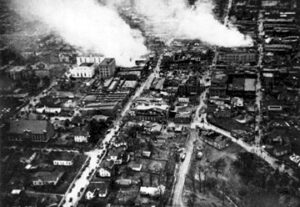 devastated as well, where 750 homes were destroyed, and 254 others were badly damaged.
devastated as well, where 750 homes were destroyed, and 254 others were badly damaged.
The Tupelo-Gainesville Outbreak took the lives of 454 people, 419 by the two main two tornadoes alone. This outbreak is the second deadliest ever recorded in United States history. Although the outbreak was centered on Tupelo, Mississippi, and Gainesville, Georgia, where the fourth and fifth deadliest tornadoes in United States history respectively occurred, other destructive tornadoes associated with the outbreak hit Columbia, Tennessee; Anderson, South Carolina; and Acworth, Georgia.
 As Easter (Resurrection Day) arrives, I find myself thinking first of Good Friday. As a Christian, I have always felt quite saddened about the need for our savior to die on the cross, and yet, we were a lost and defeated world. We had no hope of salvation, or freedom of religion…whether we knew that or not. Prior to Jesus coming, the world’s religious views were very mixed up, with the worship of Pagan god’s and other beliefs that would get us a one-way ticket to Hell. Jesus came to show us the one true way to Heaven. The Bible says in John 14:6, “I am the way, the truth, and the life. No one comes to the Father except through Me.” Jesus was our way out of the horrible mess we had gotten ourselves in. Though guilty of no sin, Jesus became sin for us that we might be saved. And…it is a free gift to us!!
As Easter (Resurrection Day) arrives, I find myself thinking first of Good Friday. As a Christian, I have always felt quite saddened about the need for our savior to die on the cross, and yet, we were a lost and defeated world. We had no hope of salvation, or freedom of religion…whether we knew that or not. Prior to Jesus coming, the world’s religious views were very mixed up, with the worship of Pagan god’s and other beliefs that would get us a one-way ticket to Hell. Jesus came to show us the one true way to Heaven. The Bible says in John 14:6, “I am the way, the truth, and the life. No one comes to the Father except through Me.” Jesus was our way out of the horrible mess we had gotten ourselves in. Though guilty of no sin, Jesus became sin for us that we might be saved. And…it is a free gift to us!!
I always thought of the horrible crime that was committed upon Jesus on Good Friday, and wondered how that awful day could be call “good,” but that is what God calls it…Good Friday. It was the day that everything was made right again, and it was a reason to celebrate. Jesus came to Earth, was scourged, bled, and died…for us. It was Jesus finished work on the cross that gives us victory over every situation in our lives. God knew we  could never fix our present situation on our own. We needed a savior to change things for us, and Jesus came to be that savior.
could never fix our present situation on our own. We needed a savior to change things for us, and Jesus came to be that savior.
As we celebrate this Easter season, better described as Resurrection Day, we all need to be mindful of the sacrifice our Lord and Savior made so that we can live a successful life full of day of Heaven on Earth, and when our days are done, we know that we can have the promise of eternal life in Heaven after we pass from this life, and it’s all because we have placed our trust in Jesus…the Way, the Truth, and the Life. He is Risen!!! May you all have a wonderful Resurrection Day…and God bless you all.


